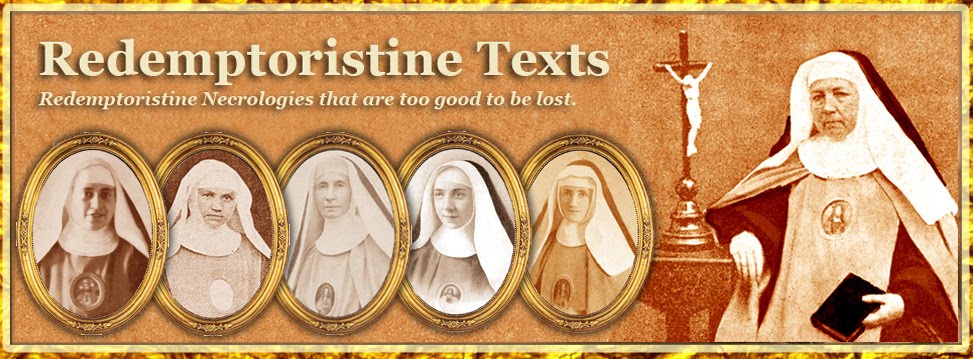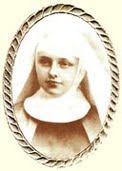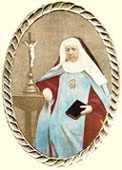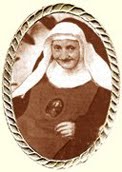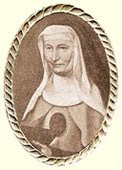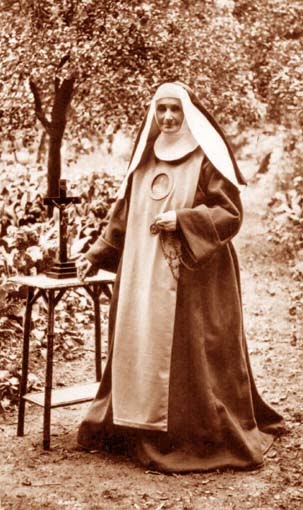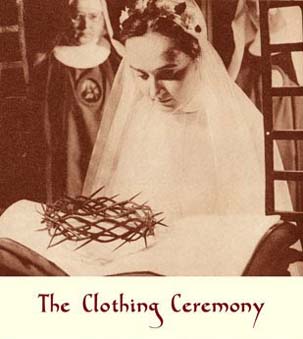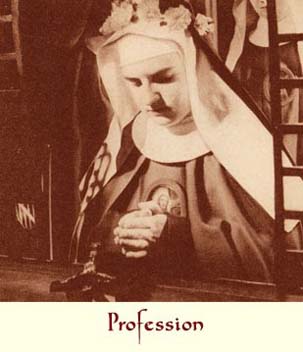Chapter IX.
The Superior. - Her religious virtues.
The Superior. - Her religious virtues.
Mother Mary-Aloyse brought a very serious preparation to the exercise of her new responsibility: a profound piety, a knowledge of affairs, a perfect devotion and a well-tested virtue.
On this last point, it is of benefit to listen to one of the Sisters who knew her best. “The spirit of sacrifice,” says Sister Mary-Anne-Thérèse of the Sacred Heart of Jesus, “was, in my humble opinion, the distinctive character of her soul. Abnegation and forgetfulness of self became in her like a second nature. These two virtues were often the subject of her exhortations to novices while she was their mistress, and the community when she became their Superior.
“Her faith was lively and efficacious. She did not want her Daughters to have a faith which was no more than just a simple sentiment. When one of them said to her one day following a high Mass, “Oh how much I love the chant of that beautiful verse Et homo factus est!”, the Reverend Mother replied to her, “Are you then making an act of living faith in the mystery of the Incarnation?” - This faith showed itself in her maintaining herself in choir, in her piety when she was chanting the Divine Office, and in her zeal for the observances of the least of the rubrics. It was manifested above all in her devotion to the Most Holy Sacrament. During her retreats, she loved to remain before Jesus, veiled in the Eucharist. One day when speaking of the hermitages which are often mentioned in the lives of the first Carmelites, she exclaimed, “They have their hermitages, but we have the Tabernacle!” One day a religious was tempted by discouragement. She said to her, “Why don’t you just go up to Our Lord exposed in the Oratory and ask Him if He could ever abandon you, when He let Himself be taken captive for love of us.”
“She was very sensitive to the outrages offered to the Divine Host of the Tabernacle. If she learned that a sacrilege had been committed, even if it was in a distant country, she would immediately celebrate a Mass in reparation to the injury done to the Most Holy Sacrament.
“Following the example of Saint Alphonsus, she loved to go during the afternoon rest-time and pick some violets, which she then placed straight away on the altar in the Oratory.
“The Redemptorist Fathers of Tournai kept seven lighted lamps before the Holy Sacrament. When our Mother learned of it, she wanted to imitate them, and supported by many benefactors, she did not delay in realising her project. The seven lamps in the sanctuary are therefore a permanent witness to her devotion to the Eucharist.
“As a true daughter of Saint Alphonsus, the Reverend Mother Mary-Aloyse had a special devotion to the Passion of the Saviour. When she became Superior, she had a very beautiful bas-relief placed in the Oratory, representing the agony of Our Lord in the Garden of Olives. She had a great stone sculpture made for the convent garden, representing Jesus bearing His cross. She also increased the number of crucifixes placed in the corridors of the Monastery. She also sought to elevate our hearts and spirits more and more towards our divine Redeemer. To excite us to make reparation for the blasphemies which so cruelly wound the Heart of Jesus, she had some pictures of His Holy Face placed in the church and in various parts of the convent. Every week a lamp would shine before them from Thursday afternoon to Friday evening.
“Our venerated Superior also witnessed her faith by her devotion to the holy relics, the Agnus Dei (Lamb of God) and holy water. She had a remarkable ability for making reliquaries. How great was her joy, then, when she had custody, for a period of time, of Saint Alphonsus’ pectoral cross! She allowed it to be venerated, not just by her Daughters, but also by all the Redemptorists who visited Bruges.”
Her Hope. - She expressed herself entirely in this prayer that she composed on the basis of the advice given to her by the Ven. Father Passerat, and which this great Servant of God annotated with his own hand.
“My God, I firmly believe that You are all-powerful, infinitely good and faithful to Your promises. You have said that You will refuse nothing of what is asked of You in the name of Jesus Christ. You are able to make me a saint: I ask it in the name of Jesus Christ and through His merits. I would like You to accord me this grace. You cannot fail in Your promise. I also wish You to grant me the ability to correspond faithfully to the lights, inspirations and graces that You will accord me (I have no doubt of this) so that I may become a saint, a great saint, a true bride of Jesus Christ, a fervent Redemptoristine who has all power over Your heart, to obtain everything I am requesting for Your glory. Finally, I wish to love You absolutely with all my heart and also be greatly loved by You. I wish to become so agreeable to Your eyes that I can console Your heart from the outrages that it receives every day.” - The Venerable Father Passerat wrote the following lines in his own handwriting, after this prayer. “From Your goodness and greatness I have an even more heightened idea of how I, earthworm and poor sinner that I am, can dare say to You, I want this grace, without You being offended by it, but are rather honoured by it, oh great God. Tell me: who am I and who are You!”
“The Reverend Mother’s hope had, moreover, passed through the crucible of tribulation. For a rather long time, at the beginning of her religious life, she was assailed by scruples and interior pains. Her obedience to her director (who was then Father Paul Reyners) saved her. From that time on she had a very maternal compassion for souls afflicted in that way. It so happened that one day, a young religious often tormented by her fear of having failed at poverty, went to see her. She accused herself of some trifling wastefulness in her manual work, and added, “In the world, I would never have stolen, but in the convent I often commit little acts of theft.” The good Mother explained things to her and calmed her down. But some days later, meeting up with the same Sister and finding her probably still a little bit worried, she said to her pleasantly, “What have you stolen today?” The little joke completed what reasoning had begun. The temptation disappeared and never returned.
“Finally we would like to indicate the Reverend Mother’s confidence in the divine Providence. Some days before her last illness, she went for a walk in the garden with the community. Seeing the trees being violently shaken by the wind, she said to us, “This is a good example of life. At certain moments everything is agitated in us and around us, and we think that all is lost, but at the moment willed by God, everything calms down and falls back into order. Never lose sight of this Providence which governs us.”
“This confidence attracted great graces to her. Often, when the occasion to do a fairly considerable good work was offered to her charity and zeal, she would receive unexpected help which she had asked for only from our Heavenly Father. We can be sure, without fear of being wrong, that this virtue was perfected even more in our Mother when she passed under the direction of the Rev. Father John Kockerols, in 1874. This eminent religious, this Father of our community, said one day that he could not be even ten minutes in prayer without feeling dominated by the thought of God’s Providence.”
Her love for God. - This love was very noticeable in the Reverend Mother Mary-Aloyse. All her works and her holy life were based on her faith. The will of God was the mover of all her actions, and was also her consolation in her sufferings.
“Just remember”, she said in her final days to a converse Sister, “just remember that holiness does not consist of a communion or a way of the cross, but in fulfilling the will of God. The most holy works harm our souls if they are done outside the will of God. You will understand this later on. I shall ask our good God and Saint Alphonsus to enlighten you about it, and when I am in heaven, I shall ask it even more urgently because of the love I have for your perfection. I shall bear you in my heart to Paradise.”
To this tender love for God, our good Mother added piety to the Saints. She professed a particular devotion to the Most Holy Virgin. Above all she loved to invoke the Immaculate Conception and Our Lady of the Seven Sorrows. This last point is quite remarkable. The Mother of Sorrows is always particularly dear to those who most greatly love Our Lord and pray for the salvation of souls.
Saint Joseph, the saint with the kind and tranquil heart, “the father of cordial love”, was dear to her also. She loved to invoke him in all the spiritual and temporal needs of the community. Her devotion to this good Saint was candid and simple. Around the neck of a little statue of the holy Patriarch she hung a letter one day in which she expressed her difficulties and desires to him in entire confidence.
The heart of this true daughter of Saint Alphonsus beat strongly for this great Saint. She loved him as her Father and holy Founder. She loved and propagated his works, which are so pious and so clear. She inculcated his teachings in her daughters. Above all she loved to preach to them her own zeal for the salvation of souls, and it was with a profound joy that she saw the Rev. Father Bloete give an entirely apostolic character to the solemn Octave of Saint Alphonsus, preached every year in the Monastery chapel. What joy she had when she learnt that many sinners were converted during these days of salvation, and how much she loved to reward in her own way the Fathers who preached the exercises there! She would obtain for them the relaxation of being able to go and spend a day by the sea at Ostend to recover their strength. (Great progress has been made since then, and even Bruges has become a seaport!). And so a certain proverb soon became true, “It is through the Mother of Bruges that we go to the North Sea.” *
The good Mother honoured Saint Gerard and blessed Father Hofbauer with a tender devotion. These great servants of God recalled so many memories and blessings to her! And another remarkable thing! Among Saint Alphonsus’ first companions, she especially venerated Father Alexander de Meo, of whom the holy Doctor said that his wisdom gave an idea of God’s wisdom.
She often recalled the venerable Father J. Passerat in her conversations. His great virtues and his admirable teachings often furnished her with material for pious dialogues, but what she also loved in him were his social virtues and his good education which added so greatly to his true piety.
Every Order has its devotions and its prayers, and its chosen customs. Mother Mary-Aloyse loved those of her own Order. Speaking just now of just prayers, she wished to preserve them intact and facilitate their usage. To this end she assembled in a little volume all the exercises of piety which are in use in the Redemptoristine Institute. She published them in 1887, on the occasion of the first centenary of the death of Saint Alphonsus, under the title of Manuel de prières à l’usage des Religieuses du T. S. Rédempteur (Manual of Prayers used by the Religious of the Most Holy Redeemer). Mons. Faict, the Bishop of Bruges, approved them as “excellent”, the Most Rev. Father Mauron declared them to be “very well done” and the Most Rev. Father Kockerols, in a prefacing letter addressed to the Reverend Mothers Superior of the Redemptoristines at Bruges, Malines, Louvain and Soignies, demonstrated clearly their incontestable utility.
We have already admired in our good Mother her love for the poor. She loved them tenderly and sought to help them in every way. And so she was happy to see her daughters, on her feast day and offer for them some manual work or surprises intended to help the poor. And also, with the same intention, she also set up a little clothing room to which she sometimes had recourse, in winter for example, in favour of her own daughters.
Poverty and obedience, these two principal virtues of religious life, also shone out with a supreme brightness in the life of Mother Mary-Aloyse. “She loved poverty, as the Rule said, even more than worldly people love their wealth, and she had the ambition of being poor in everything. What she had for her own use was marked with the coin of poverty, which is a detail rather rare among people who are very generous to others. However, this generosity had its limits. “During her forty-six years of religious life,” says a well-informed witness, “she refused herself the satisfaction of sending the least picture to her family, and if, on the approach of death, she gave her own folk some poor little prints, it was only on the insistence of her religious niece, and after having obtained permission from the Most Rev. Father Kockerols, the extraordinary confessor of the community.
Her obedience was no less edifying. Once elected Superior, she followed the advice of the Most Rev. Father Kockerols about her personal conduct with a perfect submission, and this man, so wise and so reserved in his judgements, paid a resounding tribute to this humble obedience.
Her humility was genuine. Her attraction for a life hidden in God never deterred her from courageously fulfilling her duties, but in carrying out her obligations to her best ability, she paid no regard or indulgence to herself. She never let her family know about the responsibilities she had in the convent, and if they learnt one day that she had become the Superior, it was through her niece, already a Redemptoristine at that moment. Never at any time did she boast of her position to grant herself privileges or exemptions. It cost her extremely dear, she avowed one day in private, to preside over the Chapter of faults. She would then go and pray for her Sisters and abase herself before God for her own faults.
There was no lack of people who asked her for her blessing, in the parlour for example. She would get out of it all good-naturedly, “May Jesus and Mary bless each one of us!” she would reply, and that was all. This was a little touch worthy of the Little flowers of Saint Francis of Assisi. In July 1886, the Reverend Mother Mary-Anne-Joseph, the Superior of the Redemptoristines at Malines, came to Bruges with her Mother Vicar (Sister Mary-Marguerite, still living) with the purpose of discussing some points relative to the Institute with Mother Mary-Aloyse. She was received at the door of the cloister by this dear Mother, accompanied by her counsellors. The good Mother from Malines could not wait to prostrate herself at the feet of Mother Mary-Aloyse, but she in her turn went down on her knees, and the benediction turned into a fraternal accolade. Then the good Mother led her dear visitors into the recreation room, where the community welcomed them with the chant of the Ecce quam bonum (Behold how good).
Such were the sweet virtues which were practised at the Monastery of Bruges. Under the influence of such examples, all hearts opened to confidence and to the love of Jesus and Mary, and the practice of the most difficult virtues were despoiled of their harshness to give way to the love of our divine Redeemer and His most holy Mother.
* There is an untranslatable pun in French here. Mère (Mother) sounds exactly the same as Mer (Sea): “It is through the Mère (Mother) of Bruges that we go to the Mer (sea) of the North.”
This necrology is translated from Fleurs de l'Institut des Rédemptoristines by Mr John R. Bradbury. The copyright of this translation is the property of the Redemptoristine Nuns of Maitland, Australia. The integral version of the translated book will be posted here as the necrologies appear.
